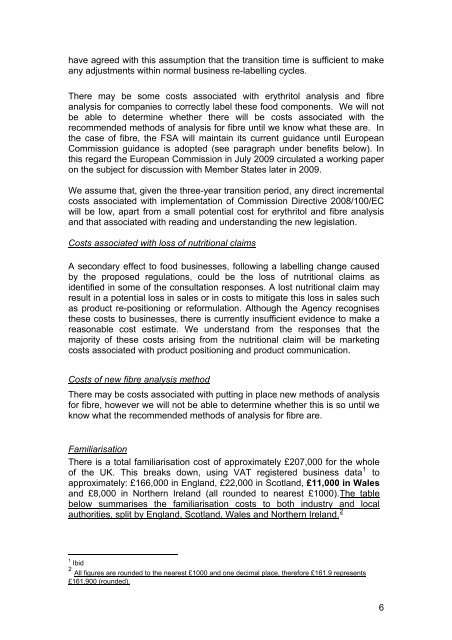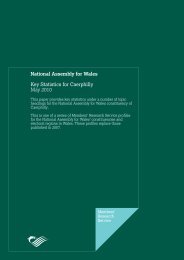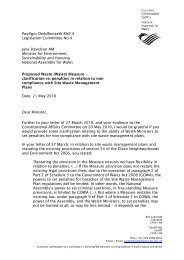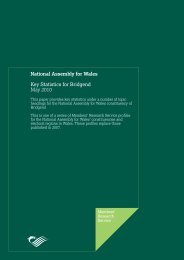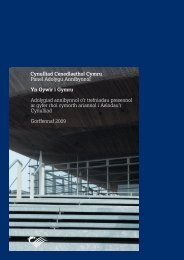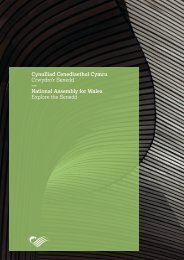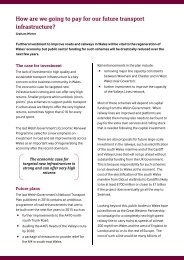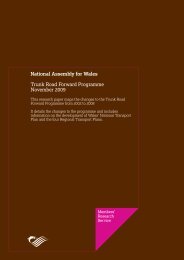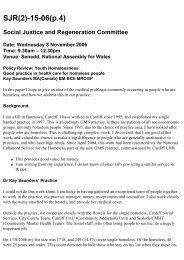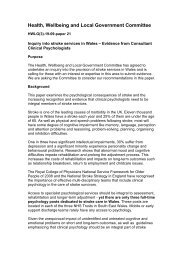Explanatory Memorandum to the Food Labelling (Nutrition
Explanatory Memorandum to the Food Labelling (Nutrition
Explanatory Memorandum to the Food Labelling (Nutrition
Create successful ePaper yourself
Turn your PDF publications into a flip-book with our unique Google optimized e-Paper software.
have agreed with this assumption that <strong>the</strong> transition time is sufficient <strong>to</strong> makeany adjustments within normal business re-labelling cycles.There may be some costs associated with erythri<strong>to</strong>l analysis and fibreanalysis for companies <strong>to</strong> correctly label <strong>the</strong>se food components. We will notbe able <strong>to</strong> determine whe<strong>the</strong>r <strong>the</strong>re will be costs associated with <strong>the</strong>recommended methods of analysis for fibre until we know what <strong>the</strong>se are. In<strong>the</strong> case of fibre, <strong>the</strong> FSA will maintain its current guidance until EuropeanCommission guidance is adopted (see paragraph under benefits below). Inthis regard <strong>the</strong> European Commission in July 2009 circulated a working paperon <strong>the</strong> subject for discussion with Member States later in 2009.We assume that, given <strong>the</strong> three-year transition period, any direct incrementalcosts associated with implementation of Commission Directive 2008/100/ECwill be low, apart from a small potential cost for erythri<strong>to</strong>l and fibre analysisand that associated with reading and understanding <strong>the</strong> new legislation.Costs associated with loss of nutritional claimsA secondary effect <strong>to</strong> food businesses, following a labelling change causedby <strong>the</strong> proposed regulations, could be <strong>the</strong> loss of nutritional claims asidentified in some of <strong>the</strong> consultation responses. A lost nutritional claim mayresult in a potential loss in sales or in costs <strong>to</strong> mitigate this loss in sales suchas product re-positioning or reformulation. Although <strong>the</strong> Agency recognises<strong>the</strong>se costs <strong>to</strong> businesses, <strong>the</strong>re is currently insufficient evidence <strong>to</strong> make areasonable cost estimate. We understand from <strong>the</strong> responses that <strong>the</strong>majority of <strong>the</strong>se costs arising from <strong>the</strong> nutritional claim will be marketingcosts associated with product positioning and product communication.Costs of new fibre analysis methodThere may be costs associated with putting in place new methods of analysisfor fibre, however we will not be able <strong>to</strong> determine whe<strong>the</strong>r this is so until weknow what <strong>the</strong> recommended methods of analysis for fibre are.FamiliarisationThere is a <strong>to</strong>tal familiarisation cost of approximately £207,000 for <strong>the</strong> wholeof <strong>the</strong> UK. This breaks down, using VAT registered business data 1 <strong>to</strong>approximately: £166,000 in England, £22,000 in Scotland, £11,000 in Walesand £8,000 in Nor<strong>the</strong>rn Ireland (all rounded <strong>to</strong> nearest £1000).The tablebelow summarises <strong>the</strong> familiarisation costs <strong>to</strong> both industry and localauthorities, split by England, Scotland, Wales and Nor<strong>the</strong>rn Ireland. 21 Ibid2 All figures are rounded <strong>to</strong> <strong>the</strong> nearest £1000 and one decimal place, <strong>the</strong>refore £161.9 represents£161,900 (rounded).6


